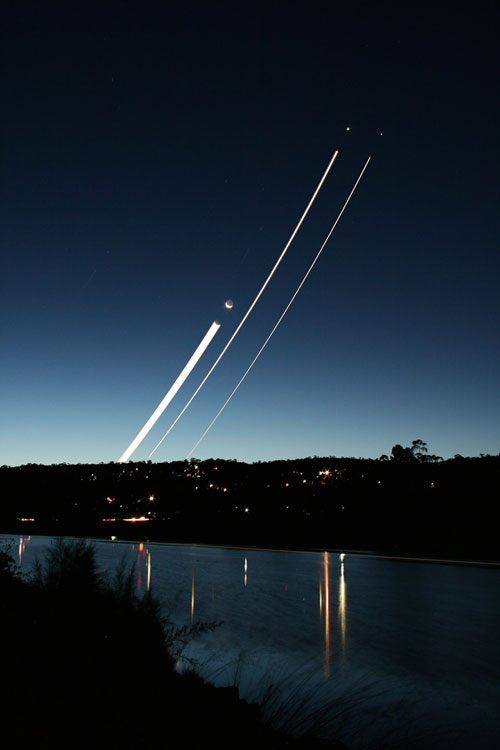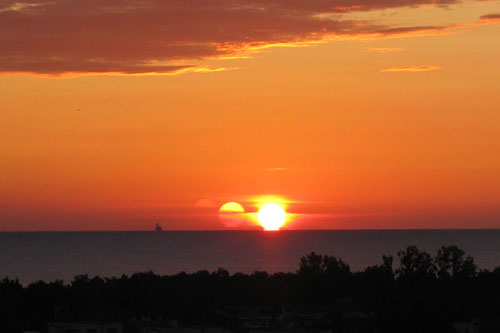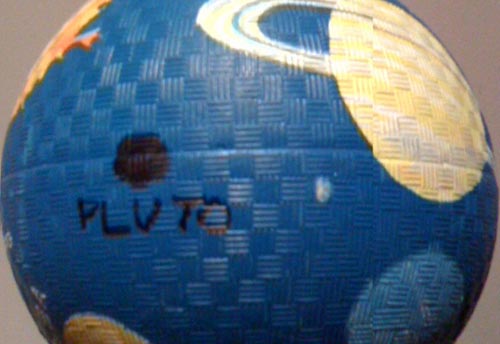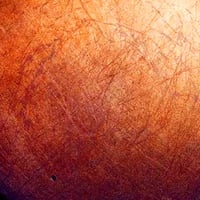kottke.org posts about astronomy
The Royal Observatory has announced the winners of its Astronomy Photographer of the Year contest.

I had no idea that images this sharp and detailed could be taken with non-pro ground telescopes…particularly these shots of the Horsehead Nebula and the surface of the Moon. More winners listed here.
Update: Jonathan Crowe notes that the gear used to take these photos isn’t cheap.
The winner’s photo of the Horsehead Nebula (mpastro2001 also had a second photo in the top five) used a 12 1/2” Ritchey-Chretien telescope ($21,500) and an SBIG STL11000 camera ($7,195 and up) with an AO-L adaptive optics accessory ($1,795) on a Paramount ME mount ($14,500). Total cost for just the equipment mentioned here: $44,990.
A massive solar flare on September 1, 1859 “caused the most potent disruption of Earth’s ionosphere in recorded history”.
Within hours, telegraph wires in both the United States and Europe spontaneously shorted out, causing numerous fires, while the Northern Lights, solar-induced phenomena more closely associated with regions near Earth’s North Pole, were documented as far south as Rome, Havana and Hawaii, with similar effects at the South Pole.
(via the browser)
In early July, a photographer took a picture of what appears to be three Suns rising over Gdansk Bay in Poland.

The photographer insists that the effect was not created by the camera and was visible to the naked eye. The early consensus in the forums is that the photo was taken through a double-paned window.
We Choose the Moon is a site that tracks the activities of the Apollo 11 mission as it happened 40 years ago. Nice work. The transmissions from the spacecraft, CAPCOM, and the lunar lander are cleverly published to and pulled in from Twitter.
With all this 40th anniversary stuff, I’m having trouble getting my mind around that the first Moon landing is as far removed from the present as the low point of The Great Depression was from my birth (i.e. the Moon landing, culturally speaking, is Ollie’s Great Depression). See also timeline twins. (via jimray)
From the folks who brought you The Periodic Table of Videos, Sixty Symbols is a series of videos on the symbols used in physics and astronomy. (via snarkmarket)
The scamps at Nature are updating the ApolloPlus40 Twitter account as the Apollo 11 mission happened 40 years ago. (thx, matt)
Oliver Morton fills us in on the current happenings in the search for planets outside of our solar system. A friend of his clued him in on a technique that could be used to not only discover planets but to determine if those planets show signs of supporting Earth-like life.
When they are passing in front of their stars, their atmospheres are backlit in a way that can make spectroscopic analysis of the different chemicals in their atmospheres comparatively easy: the wavelengths of light absorbed by the various chemicals will show up, in a tiny way, in the spectrum of the starlight. And this is what makes it possible to imagine looking at them for signs of life.
What scientists would look for are planets with unstable atmospheres, which James Lovelock said was an indication of life.
After the extragalactic planet post this morning, Sam Arbesman sent me a link to systemic, a blog dedicated to the search for extrasolar planets written by Greg Laughlin, one of the scientists involved in the effort. Here are two relevant posts. In Forward, Laughlin says we’re very close to finding a nearby Earth-like planet:
Detailed Monte-Carlo simulations indicate that there’s a 98% probability that TESS will locate a potentially habitable transiting terrestrial planet orbiting a red dwarf lying closer than 50 parsecs. When this planet is found, JWST (which will launch near the end of TESS’s two year mission) can take its spectrum and obtain resolved measurements of molecular absorption in the atmosphere.
In Too cheap to meter, Laughlin presents a formula for the land value of such a discovery that depends on how far away the planet is, the age of the star it orbits, and the star’s visual magnitude.
Applying the formula to an exact Earth-analog orbiting Alpha Cen B, the value is boosted to 6.4 billion dollars, which seems to be the right order of magnitude. And applying the formula to Earth (using the Sun’s apparent visual magnitude) one arrives at a figure close to 5 quadrillion dollars, which is roughly the economic value of Earth (~100x the Earth’s current yearly GDP)…
Scientists may have found the first planet located in another galaxy. The evidence is a little sparse but the search technique they’re using is solid.
The idea is to use gravitational microlensing, in which a distant source star is briefly magnified by the gravity of an object passing in front of it. This technique has already found several planets in our galaxy, out to distances of thousands of light years. Extending the method from thousands to millions of light years won’t be easy, says Philippe Jetzer of the University of Zurich in Switzerland, but it should be possible.
Using a Chilean telescope, astronomer Debra Fischer is leading a team searching for Earth-like planets around Alpha Centuri, our sun’s nearest stellar neighbor.
RV shifts are how the vast majority of extrasolar worlds have been discovered, but only because these planets, called “hot Jupiters,” are extremely massive and in hellishly close orbits around their stars. Their stellar wobbles are measurable in meters per second; seeing the much smaller centimeters-per-second wobble of an Earth twin is orders of magnitude more difficult. For the Alpha Centauri system, the feat is akin to detecting a bacterium orbiting a meter from a sand grain-from a distance of 10 kilometers. But by devoting hundreds of nights of telescope time to collecting hundreds of thousands of individual observations of just these two stars, Fischer believes she can eventually distill the faint RV signal of any Earth-like planets. It’s simply a matter of statistics and brute force. The planets wouldn’t reveal themselves as images in a telescope, but as steadily strengthening probabilistic peaks.
An excerpt from one of Galileo Galilei’s letters to Don Virginio Cesarini:
Long experience has taught me this about the status of mankind with regard to matters requiring thought: the less people know and understand about them, the more positively they attempt to argue concerning them, while on the other hand to know and understand a multitude of things renders men cautious in passing judgment upon anything new.
Want more Galileo? The Istituto e Museo di Storia della Scienza in Florence is loaning out their exhibit, Galileo, the Medici and the Age of Astronomy to The Franklin in Philadelphia. It features one of the last two telescopes belonging to the astronomer, as well as his notes, paintings, and other instruments, including the cylindrical sundial and Michelangelo’s compass.
Bad Astronomy has its list of the top 10 astronomy pictures of 2008 up. It includes this video of the moon orbiting the earth, comprised of a series of photos taken by a reassigned space probe.
There has never been a generation of humans in all of history who could see such an event. If you ever get a little depressed, or lonely, or think like there’s nothing going on that’s interesting any more, think on that for a moment or two. A thousand generations of people could only imagine such a thing, but we can actually do it.
(thx, amos)
The universe is trying to kill us, let us count the (ten) ways.
Start worrying in a few million years about a cosmic dust collision, when the sun hits the closest spiral arm of our galaxy. Take your chances with an exploding star. Or manage to escape these threats, and you just get an extra 10^35 years before all matter decays anyway.
Meg bought Ollie this ball a couple of weeks ago. It’s got all the planets of the solar system on it, plus the Sun. But no Pluto. That’s right, it’s barely been two years since Pluto was demoted to dwarf planet status and the toy manufacturers have already made the adjustment.
It saddens me that Ollie has to grow up in a world where Pluto isn’t considered a planet, although I take comfort that his textbooks probably won’t be updated by the time he’s in school. In the meantime, I’ve Sharpied Pluto onto his ball.

One ball at a time people, that’s how we win.
Observe sunspots by going to Grand Central Terminal?
The southern wall of the Grand Concourse, facing 42nd Street, has semicircular grills high up, with small curlicued spaces like those in a leafy tree. Many of those spaces act like the aperture of a pinhole camera, reflecting an image of the sun that, when it reaches the floor, will be 8 to 12 inches wide. The smaller grill spaces will produce dimmer but sharper solar images on your paper.
(via 92y blog)
From Harvard Magazine, an appreciation of the work that the Hubble telescope has done since its 1990 launch into orbit.
The “Pillars of Creation” may be the most iconic Hubble photograph ever taken. “Located in the Eagle Nebula, the pillars are clouds of molecular hydrogen, light years in length, where new stars are being born,” says Aguilar. “However, recent discoveries indicate these pillars were destroyed by a massive nearby super nova some 6,000 years ago. This is a ghost image of a past cosmic disaster that we won’t see here on Earth for another thousand years or so-and a perfect example of the fact that everything we see in the universe is history.”
The Hubble Space Telescope was launched into space 18 years ago and to celebrate, NASA has put up a photo gallery of merging galaxies, galaxies as in love with each other as NASA is with the Hubble. Aww.
A photograph of the newest possible moon, one that’s only about 15 hours old.
Finding the Moon when its slim crescent is still less than about 24 hours past the New Moon phase requires careful timing and planning, a challenging project even for experienced observers. In this sighting, only about 0.8 percent of the Moon’s disk appears illuminated.
(via airbag)
The Earth and Moon as seen from Mars.

The Hubble telescope recently captured an image of a double Einstein Ring.
An Einstein Ring happens when two galaxies are perfectly aligned. The closer galaxy acts as a lens, magnifying and distorting the view of a more distant galaxy. But today astronomers announced that they’ve discovered a double Einstein Ring: three galaxies are perfectly aligned, creating a double ring around the lensing galaxy.
A list of the top 10 astronomy images of 2007, including entwined galaxies and a dying star.
On the origin of the Earth’s moon and how our planet would be different if we didn’t have a moon.
The Moon has been a stabilizing factor for the axis of rotation of the Earth. If you look at Mars, for instance, that planet has wobbled quite dramatically on its axis over time due to the gravitational influence of all the other planets in the solar system. Because of this obliquity change, the ice that is now at the poles on Mars would sometimes drift to the equator. But the Earth’s moon has helped stabilize our planet so that its axis of rotation stays in the same direction. For this reason, we had much less climatic change than if the Earth had been alone. And this has changed the way life evolved on Earth, allowing for the emergence of more complex multi-cellular organisms compared to a planet where drastic climatic change would allow only small, robust organisms to survive.
Comet Holmes brightened a millionfold late this week and has become visible to the naked eye, even in bright cities. The second chart on this page shows how quickly the comet shot up in brightness.
Using adaptive optics, which corrects for atmospheric distortion, some astronomers have modified a ground telescope to yield sharper images than the Hubble.
Hubble’s optics provide greater detail over a wider angle, while the Lucky camera as used at Palomar gives ultra-high resolution only for a tiny slice of the sky at one time.
This New Yorker article on light pollution makes mention of the Bortle Dark-Sky Scale, which is a measure of how bright the stars are in a particular part of the sky.
In Galileo’s time, nighttime skies all over the world would have merited the darkest Bortle ranking, Class 1. Today, the sky above New York City is Class 9, at the other extreme of the scale, and American suburban skies are typically Class 5, 6, or 7. The very darkest places in the continental United States today are almost never darker than Class 2, and are increasingly threatened. For someone standing on the North Rim of the Grand Canyon on a moonless night, the brightest feature of the sky is not the Milky Way but the glow of Las Vegas, a hundred and seventy-five miles away. To see skies truly comparable to those which Galileo knew, you would have to travel to such places as the Australian outback and the mountains of Peru.
Arecibo Observatory, the world’s largest radio telescope, is in danger of being shut down due to budget cuts. Arecibo could run for almost two years for the cost of a single F-16 fighter jet…to say nothing of the small fraction of the cost of the War in Iraq required.
Is the search for aliens such a good idea? If/when we find evidence of extraterrestrial intelligent life, will they welcome us as neighbors, treat us as vermin in their universe or something inbetween? “Jared Diamond, professor of evolutionary biology and Pulitzer Prize winner, says: ‘Those astronomers now preparing again to beam radio signals out to hoped-for extraterrestrials are naive, even dangerous.’”
Newer posts
Older posts









Stay Connected